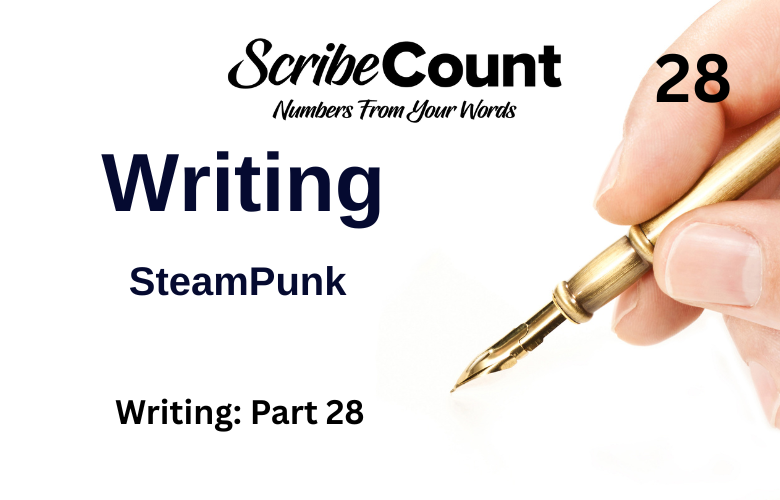Steampunk for Indie Authors: How to Write a Thrilling Tale of Adventure and Invention
Steampunk is a genre that blends the romance of the Victorian era with futuristic technology, often creating an alternate history where steam power, airships, and clockwork gadgets reign supreme. It’s a genre filled with adventure, science fiction, and often a sense of whimsy or rebellion. Steampunk novels typically explore the potential of technology, society, and class while combining historical settings with fantastical elements like advanced machinery, airships, automatons, and mechanical inventions that defy the rules of the time period.
For indie authors, writing a steampunk novel presents an exciting opportunity to create a world that blends the aesthetic of the past with the imagination of the future. It allows for innovative world-building, complex characters, and a chance to explore social themes through the lens of a fantastical world. Whether your story is set in an alternate Victorian England, a futuristic steampunk city, or a world where steam technology is the cornerstone of society, the key is to balance the adventurous spirit with the technological and societal elements that define the genre.
This guide will walk you through the essential elements of writing a steampunk novel, from creating an immersive world to developing engaging characters and weaving complex plots that reflect the genre’s core themes of innovation, rebellion, and social conflict.
What Makes a Steampunk Novel?
A steampunk novel is defined by its setting, which is typically rooted in the Victorian era or an alternate version of history, but with the introduction of futuristic technology powered by steam. In a steampunk world, steam engines, mechanical contraptions, airships, and clockwork devices are the height of technological advancement. These devices often serve as tools for exploration, rebellion, or invention, providing a sense of both the fantastical and the mechanical.
One of the core elements of steampunk fiction is its world-building. The setting is integral to the genre, often blending the past with the imagined future. Steampunk worlds are often filled with sprawling cities, intricate machinery, and a sense of both elegance and grit. Cities may be powered by steam engines, airships may cruise through the skies, and automatons may walk the streets alongside humans. The aesthetic is often Victorian, but with an emphasis on invention, technology, and anachronistic elements that challenge the boundaries of what is possible.
Steampunk novels often feature technological innovation as a key theme. The genre imagines a world where the Industrial Revolution never ended, where steam power is more advanced than electricity, and where machines are capable of feats that seem impossible by modern standards. The technology in steampunk fiction is typically intricate, mechanical, and often Victorian-inspired. From steam-powered robots to airships with intricate clockwork mechanisms, the possibilities for invention are endless.
The characters in steampunk novels often find themselves at the intersection of progress and tradition. Many protagonists are inventors, scientists, explorers, or rebels who question the status quo. These characters may be caught between advancing technology and societal norms, often pushing the boundaries of what is acceptable or possible. The central conflict in steampunk stories often revolves around a clash between old-world traditions and new-world technologies, or a struggle for control over powerful inventions.
Finally, themes of rebellion and class struggle are common in steampunk novels. Many stories explore the disparity between the rich and the poor, the powerful and the powerless. In a world where technology has the power to elevate or oppress, steampunk often delves into questions of social justice, class mobility, and the dangers of unchecked power.
The Popularity of Steampunk Fiction
Steampunk fiction has gained significant popularity in recent years, particularly with the rise of cosplay, conventions, and a growing subculture of steampunk enthusiasts. Books like The Difference Engine by William Gibson and Bruce Sterling (available on Amazon) and Leviathan by Scott Westerfeld (available on Apple Books) have helped define the genre, offering readers a mix of historical intrigue, adventure, and technological marvels. The success of films like The League of Extraordinary Gentlemen and Wild Wild West also helped bring the steampunk aesthetic into mainstream awareness.
For indie authors, steampunk offers a unique blend of history, technology, and imagination that resonates with a wide audience. The genre’s dedicated fanbase, as well as the increasing interest in historical fiction with a twist, makes it an exciting genre to explore. Readers of steampunk often appreciate the genre’s mix of adventure, mystery, and social commentary, as well as its emphasis on invention, creativity, and the possibilities of an alternate history.
The flexibility of steampunk also makes it appealing to indie authors. Whether you want to write an action-packed adventure, a romance set in a fantastical world, or a story that critiques the consequences of industrialization, the genre provides ample room for experimentation and innovation.
Reader Expectations for Steampunk Fiction
When readers pick up a steampunk novel, they expect an immersive, detailed world filled with technological wonders, Victorian aesthetics, and a sense of adventure. The world-building is one of the most important aspects of steampunk fiction. Readers want to be transported to a world where steam power rules, where airships sail across the sky, and where robots and clockwork creatures walk the streets. The setting should feel both fantastical and grounded, with a rich, imaginative world that operates on its own rules.
Character development is another major expectation. Steampunk novels often feature protagonists who are inventors, explorers, or rebels. Readers expect characters who are complex, multidimensional, and capable of growth. These characters should grapple with questions of morality, power, and societal norms, often finding themselves at odds with the constraints of their world.
In addition to strong characters, readers expect action and adventure. Steampunk novels are often fast-paced, with the protagonists embarking on daring escapades, navigating dangerous technology, and engaging in conflicts with powerful forces. Whether it’s a thrilling chase on airships or a showdown with a rogue inventor, readers want excitement and danger to keep the story moving.
Finally, readers expect themes of innovation, rebellion, and social change. Steampunk often explores the consequences of technological advancement, with characters questioning whether progress should be embraced or feared. The genre also frequently delves into class struggles, social inequalities, and the moral implications of unchecked power.
Common Tropes in Steampunk Novels
Steampunk novels are rich with recurring themes and tropes, many of which have become iconic in the genre. Here are some of the most common tropes in steampunk fiction:
- The Mad Inventor: A character who creates groundbreaking, often dangerous, technology. The mad inventor is a staple of steampunk fiction, representing both the brilliance and the dangers of unchecked creativity.
- The Airship Captain: Often a swashbuckling hero or antihero, the airship captain embodies the adventurous spirit of steampunk, traveling across the skies in a massive steam-powered ship.
- The Clockwork Automaton: Robots or mechanical beings powered by steam or clockwork are central to many steampunk stories. These automatons are often allies or enemies of the protagonists.
- The Rebel Hero: Steampunk novels often feature protagonists who fight against societal norms or oppressive powers, whether they are battling corrupt governments, greedy industrialists, or dangerous inventions.
- The Hidden World: Many steampunk novels feature a hidden or secret world within our own, where technology and magic coexist, often behind closed doors or underground.
- The Damsel in Distress: While steampunk often features strong, independent female protagonists, the damsel in distress trope can still play a role, with the female character needing to be rescued or protected by the male hero.
- The Victorian Society: Steampunk stories are often set in a Victorian-era society, with its strict class structures, social conventions, and emphasis on manners and morality. This setting provides a rich backdrop for exploring themes of rebellion, progress, and societal change.
Structuring Your Steampunk Novel: The Plot Map
Here’s a simple plot map you can follow when planning your steampunk novel, ensuring that the world-building, character development, and adventure elements build in an engaging way:
- Normal World: Introduce your protagonist in their everyday life, showing how they navigate the constraints of their society. This is where the reader learns about their world, their personal motivations, and their relationship to the technology around them.
- Inciting Incident: Something happens that forces the protagonist to engage with the central conflict—whether it’s the discovery of a dangerous invention, a call to action from a rebellious group, or a personal mission that requires technological expertise.
- Rising Action: The protagonist sets off on their journey, encountering allies and enemies, uncovering secrets, and confronting the dangers of their world. This is where the stakes rise, and the protagonist faces challenges both internal and external.
- Climax: The protagonist faces the central threat or challenge, often involving a battle of wits, technology, or morals. The action is at its peak, with the fate of the world or the characters hanging in the balance.
- Resolution: The story concludes with the resolution of the central conflict, whether it’s the hero’s victory over a villain, the discovery of a groundbreaking invention, or the protagonist’s personal growth. The resolution provides closure while potentially setting up future adventures.
Final Thoughts for Indie Steampunk Writers
Writing a steampunk novel allows you to explore the intersection of history, technology, and imagination. The genre offers endless opportunities for world-building, adventure, and social commentary. Whether you’re writing a fast-paced adventure, a romance, or a deeply philosophical tale about the consequences of technology, steampunk provides a flexible and exciting platform for storytelling.
As an indie author, you have the freedom to create unique worlds, characters, and plots that push the boundaries of the genre. By balancing the historical elements with the fantastical, you can craft a steampunk novel that is both imaginative and grounded in real-world issues. With the right mix of adventure, invention, and social critique, your steampunk novel can captivate readers and transport them to a world of gears, steam, and endless possibility.

